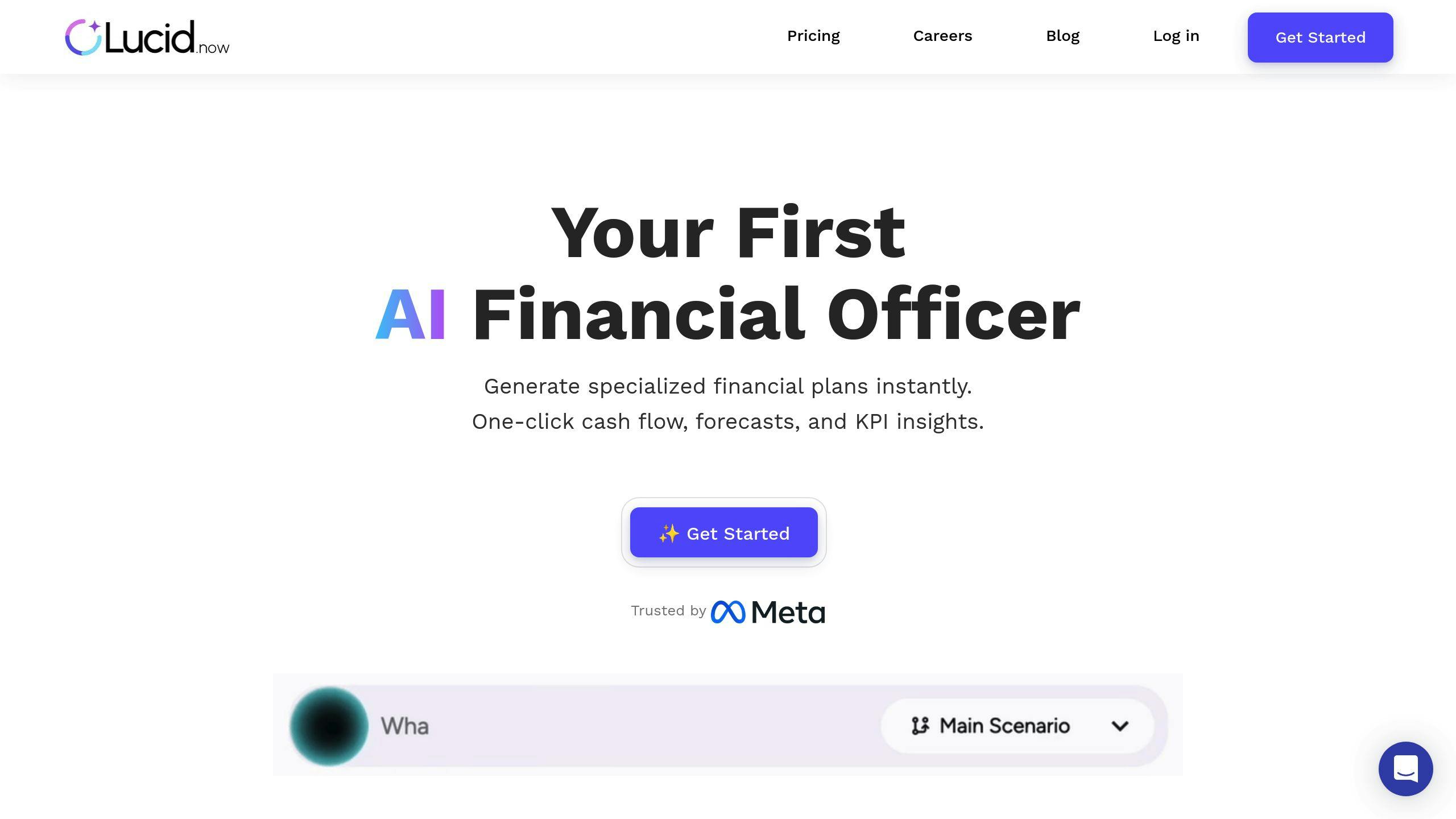Unit economics calculators help businesses figure out if they’re making money on each customer, product, or service. They focus on key metrics like Customer Acquisition Cost (CAC), Lifetime Value (LTV), and Gross Margin to measure profitability and efficiency. Here's a quick overview:
- What You Need: Gather data like revenue, costs (fixed and variable), churn rate, and customer lifetime.
- Key Metrics:
- CAC: Total marketing/sales costs ÷ new customers.
- LTV: (Revenue per customer) × (customer lifetime).
- LTV:CAC Ratio: A healthy business aims for at least 3:1.
- Why It Matters: These numbers guide decisions on pricing, marketing, and growth strategies.
- Tools: Spreadsheets work, but platforms like Lucid Financials automate calculations and provide insights.
Example: If your CAC is $150, and your LTV is $2,000, your LTV:CAC ratio is 13.3:1, meaning you’re highly profitable and ready to scale.
This guide explains how to calculate these metrics, interpret them, and improve your business strategy.
Before You Start: Required Information
Key Data Points to Gather
Before calculating unit economics, it's crucial to collect specific metrics to ensure accurate analysis. Here's what you'll need:
- Revenue: Total income from sales or services.
- Variable Costs: Expenses directly tied to production, such as materials and shipping.
- Fixed Costs: Regular expenses like salaries, rent, or leases.
- Marketing Expenses: All costs related to acquiring customers.
Customer metrics:
- Revenue Metrics: Metrics like MRR (monthly recurring revenue for subscriptions) or ARPU (average revenue per user, calculated by dividing total revenue by the number of users).
- Churn Rate: The percentage of customers who stop using your product or service.
- Customer Lifetime: The average time a customer stays with your business.
Once you’ve gathered these metrics, the next step is to understand how your business model impacts your approach to unit economics.
Business Model Considerations
Your business model will determine what defines a "unit" and which metrics are most relevant. Here's a quick overview:
| Business Model | Unit Definition | Key Metrics |
|---|---|---|
| SaaS | Per customer | MRR, Churn rate, Customer lifetime |
| E-commerce | Per transaction | Order value, Purchase frequency, Return rate |
| Marketplace | Per transaction or listing | Take rate, Transaction volume, User acquisition |
| Service-based | Per service hour or project | Billable hours, Project costs, Utilization rate |
Choosing the Right Calculator
Using the right tools to calculate unit economics is essential. While spreadsheets can handle basic calculations, specialized platforms offer more advanced features. For example, Lucid Financials integrates with systems like QuickBooks, automating data entry, providing benchmarks, and comparing different scenarios.
When evaluating calculators, consider these factors:
- Data Integration: Can it connect with your current systems?
- Automation: Does it reduce manual entry and potential errors?
- Reporting: Does it generate clear visualizations and actionable insights?
- Scalability: Will it grow with your business requirements?
"Unit economics is the most effective method to find ways to maximize your profits", say industry experts, highlighting the importance of selecting the right tools for precise analysis [2].
How to Calculate Unit Economics: Step by Step
Finding Your CAC
Customer Acquisition Cost (CAC) is a key part of understanding unit economics. To figure out your CAC, divide your total spending on customer acquisition by the number of new customers you brought in during that time.
The formula looks like this:
CAC = Total Marketing & Sales Costs / Number of New Customers
For example, say your monthly marketing spend includes $5,000 for ads, $8,000 for sales team salaries, and $2,000 for marketing tools. That totals $15,000. If you gained 100 new customers that month, your CAC would be $150 per customer.
Measuring Customer LTV
Lifetime Value (LTV) shows how much revenue you can expect from a customer over the time they stay with your business. To calculate it, multiply the Average Revenue Per User (ARPU) by the Customer Lifetime. ARPU is found by dividing Total Monthly Revenue by Total Active Customers, while Customer Lifetime is calculated as the inverse of the Monthly Churn Rate.
LTV = (Total Monthly Revenue / Total Active Customers) × (1 / Monthly Churn Rate)
Let’s break it down with an example: If your business makes $50,000 in monthly revenue from 500 customers and has a 5% churn rate, your ARPU is $100, Customer Lifetime is 20 months, and LTV comes out to $2,000.
These numbers can vary based on your business model. For instance, SaaS companies often focus on metrics like Monthly Recurring Revenue (MRR) and churn, while e-commerce businesses might look more at order value and purchase frequency.
LTV to CAC Ratio Analysis
The LTV:CAC ratio is a quick way to check if your business model is profitable and scalable:
| Ratio | What It Means | Next Steps |
|---|---|---|
| < 1:1 | Losing money | Reassess and cut costs |
| 1-3:1 | Marginal | Look for ways to improve efficiency |
| 3-5:1 | Solid | Keep growing |
| > 5:1 | Excellent | Consider scaling up |
"If your LTV does not exceed your CAC, then your business is rapidly burning money." - Accountancy Cloud [1]
Using the earlier examples:
- LTV = $2,000
- CAC = $150
- Ratio = 13.3:1
This impressive ratio suggests you could confidently increase marketing spend to grow faster while staying profitable.
Although these calculations give you a strong starting point, digging deeper into metrics like churn and CAC payback time can help refine your understanding of unit economics even further.
Extra Factors to Consider
Customer Churn Effects
Customer churn directly impacts your unit economics by lowering customer lifetime value (LTV). When churn is high, LTV drops, customer lifespans shrink, and acquisition costs rise, making it tougher to maintain growth.
To grasp the full effect of churn, track both revenue churn (lost recurring revenue) and customer churn (percentage of customers leaving).
For instance, if your monthly revenue is $100,000 and you lose $5,000 in recurring revenue, your revenue churn is 5%. But if that $5,000 comes from losing two enterprise customers out of 100 total customers, your customer churn is 2%. This shows how different customer segments can influence your metrics in unique ways.
Understanding this is key to assessing how quickly you can recover acquisition costs, which ties into CAC payback time.
CAC Payback Time
CAC payback time measures how long it takes to recover the cost of acquiring a customer. This is a crucial metric for evaluating whether your growth strategy is working. Here's the formula:
CAC Payback Time (months) = CAC / (Monthly ARPU - Monthly COGS)
| CAC Payback Time | Business Health Indicator | Action Needed |
|---|---|---|
| 0-6 months | Strong | Stick with your current approach |
| 7-12 months | Decent | Explore areas for improvement |
| 13-18 months | Weak | Adjust your strategy immediately |
| 18+ months | Problematic | Overhaul your approach |
While this metric gives an overview of efficiency, breaking it down by customer groups can highlight where to focus your efforts.
Customer Group Differences
Segmenting customers helps fine-tune your unit economics by addressing the specific characteristics of each group. Different customer segments often show distinct trends. For accurate insights, consider breaking them down by:
- Acquisition channel: Organic traffic vs. paid ads
- Customer size: Small businesses vs. large enterprises
- Industry: Retail vs. tech
- Location: Domestic vs. international markets
With access to data from multiple sources, you can track metrics for each segment and adjust your strategies to meet their specific needs. This ensures a more targeted and efficient approach to growth.
sbb-itb-17e8ec9
Making Decisions with Unit Economics
Marketing Budget Planning
Unit economics helps you make smarter marketing budget decisions by linking spending to metrics like LTV (Lifetime Value) and CAC (Customer Acquisition Cost). A good rule of thumb is aiming for an LTV/CAC ratio of 3:1 or higher. For example, if social media ads have a CAC of $100 and generate customers with an LTV of $400, while email marketing has a CAC of $50 and an LTV of $300, email marketing delivers better returns and should take priority.
When allocating your budget, keep an eye on these critical metrics:
| Channel Performance Metric | Good | Caution | Needs Attention |
|---|---|---|---|
| LTV/CAC Ratio | Over 3:1 | 2–3:1 | Below 2:1 |
| CAC Payback Period | Under 6 months | 6–12 months | Over 12 months |
| Channel ROI | Over 200% | 100–200% | Below 100% |
Customer Retention Methods
Boosting customer retention improves unit economics by increasing LTV. Here are three effective approaches:
- Personalized Engagement: Use customer behavior data to send tailored recommendations. For instance, offer advanced tips for frequently used features via in-app notifications.
- Value-Based Pricing: Adjust pricing tiers based on actual usage. Customers are more likely to stick around when pricing clearly matches their needs, often increasing LTV by 20–30%.
- Proactive Support: Set up an early warning system to monitor customer health. Track engagement and usage metrics to identify and assist at-risk customers before they churn.
Using tools like Lucid Financials can make it easier to apply these strategies and get actionable insights.
Using Lucid Financials for Planning

Lucid Financials streamlines unit economics analysis by automating calculations, offering real-time updates, and benchmarking key metrics. Its scenario planning tools let you test pricing changes and evaluate their effect on profitability. The Professional plan, priced at $150–600/month, supports unlimited scenario modeling, making it a great choice for businesses that frequently adjust their unit economics strategy.
Unit Economics for Startups
Conclusion: Main Points
Understanding how to calculate and analyze unit economics is crucial for making informed business decisions. These calculations help you assess the profitability of customers or products, highlighting areas where adjustments might be needed. The focus should always be on balancing acquisition costs with lifetime value, while consistently reviewing and refining your metrics.
Different business models approach unit economics differently. Here's a quick comparison:
| Business Type | Primary Focus | Key Metrics | Target Ranges |
|---|---|---|---|
| SaaS | Customer-level | LTV/CAC Ratio | >3:1 |
| Physical Products | Product-level | Contribution Margin | >50% |
| Service-based | Client-level | CAC Payback Period | <6 months |
To manage these metrics effectively, you'll need accurate data, regular analysis, and strategic adjustments. Tools like Lucid Financials can simplify this process by automating calculations and offering real-time insights, making it easier to track performance and fine-tune your strategies.
FAQs
How to calculate unit economics for a mobile app?
Calculating unit economics for mobile apps involves the same basic principles as other businesses but requires focusing on app-specific metrics like in-app purchases and subscription renewals. Here's a step-by-step breakdown:
-
Calculate Total Acquisition Costs
Add up all spending on user acquisition across various channels, such as paid ads, referral bonuses, and app store promotions. For example, if you spend $5,500 to acquire 160 users, your Cost Per Acquisition (CAC) would be $34.38 per user. -
Measure Revenue and Lifetime Value (LTV)
Identify revenue streams unique to mobile apps, including:- Subscription fees
- In-app purchases
- Premium features
- Ad revenue
-
Forecast Long-Term Value
Evaluate app-specific factors that impact your LTV:CAC ratio, such as:- Renewal rates
- In-app purchase trends
- Churn rates
- User engagement levels
"Having a deep understanding of your unit economics is imperative if you are going to get the most out of a paid UA strategy" [3].
To ensure sustainable growth, aim for an LTV:CAC ratio of at least 3:1. Using Calm as an example, their $120 LTV and $40 CAC hit this benchmark, showcasing a solid business model [3].


